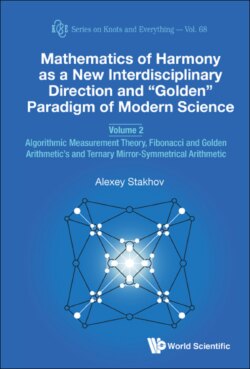Читать книгу Mathematics of Harmony as a New Interdisciplinary Direction and “Golden” Paradigm of Modern Science - Alexey Stakhov - Страница 17
На сайте Литреса книга снята с продажи.
1.5. Constructive Approach to the Creation of the Mathematical Measurement Theory
ОглавлениеIn the framework of the constructive approach to the creation of the mathematical measurement theory, the concept of the actual infinity should be excluded from the consideration due to its internal contradictoriness (the “completed infinity”).
Modern constructivist mathematicians, who consider the abstraction of actual infinity as an internally contradictory concept (the completed infinity), came up with two ideas that can become the basis of the constructive (algorithmic) theory of measurement [16]:
(1) An intuitive, “practical” idea about the finiteness of the measurement process, according to which every measurement is completed in the finite number of steps.
(2) Constructive idea of the potential feasibility, in accordance to which we ignore the limitations of our possibilities in choosing the measuring means and the number of measurement steps (i.e., the number of measurement steps is always finite and can be choosen to be arbitrarily large and there exists always the potential possibility to do the next measurement step).
Such a seemingly insignificant change in the approach to the measurement leads us to rethink many problems of the mathematical theory of measurement. With the set-theoretic approach, the measurement is carried out to the “point”, i.e., to the absolutely exact coincidence of the measurable and measuring segments (a possibility of such an absolutely accurate measurement follows from Cantor’s axiom).
With the constructive approach, the measurement never reaches the “point”, and the measurement result reduces always to certain uncertainty interval regarding the true value of the measurable quantity. By increasing the number of measurement steps, this interval narrows and can be made arbitrarily small, but this interval never turns into the “point”.
In his famous work On the Philosophy of Mathematics [130], Hermann Weil pays attention to the following distinction between the classical and constructive definitions of the continuum concept:
“In modern analysis, the continuum is considered as the set of its points; in the continuum, it sees only a special case of the basic logical relationship between an element and a set. But it is amazing that the same fundamental relationship between the whole and its part had not yet found a place in mathematics! Meanwhile, the possession of parts is the basic property of the continuum and Brauer’s theory puts this relationship in the basis of the mathematical study of the continuum. This is actually the basis of the above attempt to proceed not from points, but from intervals, as from the primary elements of the continuum”.
One of the important moments in the set-theoretic theory of measurement, based on the Eudoxus–Archimedes axiom and the Cantor axiom, is the choice of the measurement algorithm, which is defined by the numeral system, in which the measurement result is represented.
With the infinite (in terms of the actual infinity)number of measurement steps, i.e., when we are measuring up to the “point”, the measurement algorithm does not affect the final measurement result and therefore the problem of choosing measurement algorithms as a serious mathematical problem does not arise here. The choice of the measurement algorithm has an arbitrary character, and, as a rule, it reduces to the “decimal” or “binary” algorithms.
With the infinite (in terms of the potential infinity)number of measurement steps, i.e., when we are measuring up to the “interval” [130], between the measurement algorithms, there arises the difference in the measurement “accuracy”, achieved with the help of the given measurement algorithm. Let’s recall that the measurement “accuracy” is equal to the ratio of the initial uncertainty interval to the uncertainty interval on the final step of measurement. For such conditions, the constructive idea about the “efficiency” of the measurement algorithms [131] comes into play, and the problem of the synthesis of efficient or optimal measurement algorithms is put forward as the central problem of the constructive (algorithmic) theory of measurement [16].
Thus, the constructive approach to the theory of measurement leads us to the formulation of the problem, which, in essence, has never been considered in the mathematical theory of measurement as a serious mathematical problem, namely the problem of finding the “optimal” measurement algorithms. The solution of such problem led us to the creation of the algorithmic measurement theory [16], which can be considered as the constructive direction in the mathematical theory of measurement.
